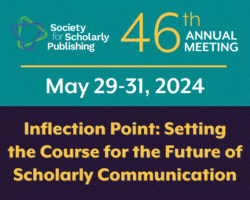June 15, 2006
The PDR/Corporate Library/Scholarly Publisher Forum which was held on June 15, 2006, right after SLA was an opportunity to compare how scholarly publishers and big-pharma purchasers view the issues of content licensing requirements, copyright, purchasing and business models, each from their own point of view. The all-day event, jointly sponsored by the Pharma Documentation Ring (PDR) and the Society for Scholarly Publishing, was moderated by SSP President Judy Luther. The format of the day, in broad terms, was presentations by PDR on issues with various aspects of content licensing and distribution followed by publisher responses, and comments from the audience, which was made up of both publisher and pharmaceutical representatives. During lunch there were presentations on archiving systems (“perpetual access”) by Portico, Clockss and PubMed.
After a brief introduction of the PDR, an association of 21 research-based pharmaceutical companies promoting exchange of experience and information both among members and between members and the information industry, the agenda started with a bang and remained lively all day with a focus on licensing issues including:
- the distribution to third parties of “one-off” articles for purposes of medical information
- the distribution and use of relatively small amounts of copies or reprints, such as 30 copies distributed by a salesman at a meeting
- content licensing for text mining
- business models in a changing environment
In the first two cases mentioned above, there are no easy mechanisms to acquire rights at what PDR members consider “reasonable” rates – as one put it “we can buy one copy or a thousand copies, but not 25.” During an extended conversation, LouAnn Dinallo from Bristol Myers Squibb said, “we need iTunes for articles.” Publishers asked PDR members to quantify this additional use within institutions, but although it was felt that the use for medical information is “occasional” and the use of 25-30 copies for meetings and workgroups was “moderate”, it was admitted that creating mechanisms to make such use easy would greatly increase use.
There was also an extended discussion that revolved around the text mining issues. Henning Nielson, President of PDR, described R&D in big pharma as undergoing a paradigm shift from traditional academic research – full text content both internal and external is used by computational algorithms rather than individual humans. Although a large number of documents may be retrieved in this process, only a small percentage of articles, and snippets of articles, are actually used in the resulting output. And outputs are new knowledge similar to that which results in putting a visualization software layer over content – something that a pharmaceutical company can do without paying publishers anything. From the PDR point of view, usage of content is exploding within organizations and will continue to do so as technology makes it easier to copy, slice, dice, mix and generally extract and use information – but current business models don’t accommodate such uses at a reasonable cost. Furthermore it is impractical to continue to negotiate and pay separately for every possible future use that technology makes available.
The ACS spoke on behalf of publishers (who soon chimed in) about pressures on business models, and the fact that usage, which has been considered a good proxy for value – is skyrocketing. Publishers are putting more and more features online for which they aren’t charging, keeping up with new technologies and updating skill sets. Submissions are up and the ACS is doing 10% more publishing while also facing tremendous price pressure. So the open question was, how does information get valued and what are good pricing models?
Members of PDR pointed out that their budgets have been flat for three years (“at BMS, the information budget is as ugly if not uglier than in academic”) and the pressure to reduce costs is tremendous – they can not support skyrocketing costs for information even if use is skyrocketing. Someone suggested that use is not a valid metric for value since ubiquitous access drives up frivolous use – downloading of documents “just in case” that never get used.
In general PDR members want content models to be more flexible – sites grow and shrink, workgroups form and re-form. From discussion it seemed that the FTE model doesn’t actually seem to work well for either side since it’s based on a number that can vary year on year based on who is reporting, organizational changes, etc. It was pointed out that concurrent user could be a way to handle this, although concurrent user model has been unpopular with some due to potential for lock-outs. Many publishers are doing away with FTE in favor of tiers or Carnegie sites and Sage Publications went to a model for non-consortia multi-sites that simply charges 100% for the first or primary site and 25% for each site thereafter.
Although its impossible in a short summary to completely capture an entire day’s worth of discussion, much of it boiled down to the fact that over the past three years rights are not expanding with the technology and existing business models won’t scale in a way that libraries can continue to support if value is measured by usage. Yet there was no clear conclusion on the part of the PDR participants as to what business models might work best, and when asked by publishers how they value information, or even what business models are workable, the PDR members simply don’t know.
Bette S. Brunelle
VP and Lead Analyst
Outsell Inc.
Phone: 518-348-1318
Fax: 518-348-1917


